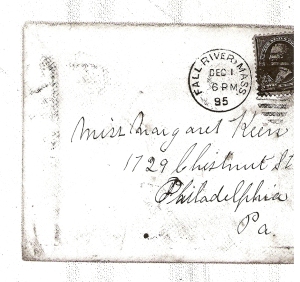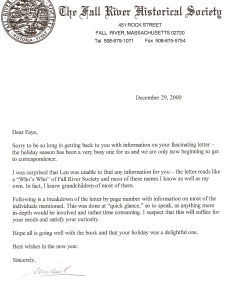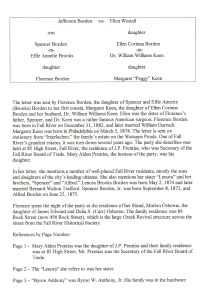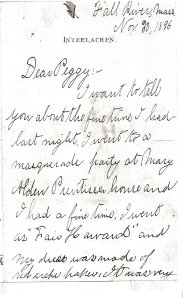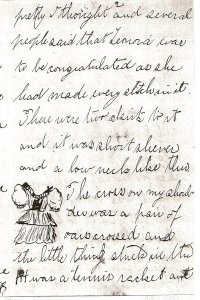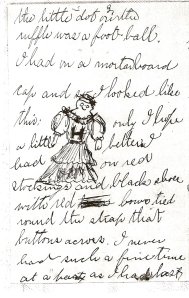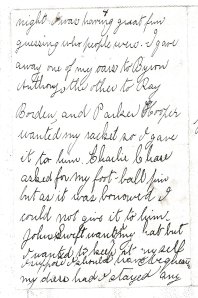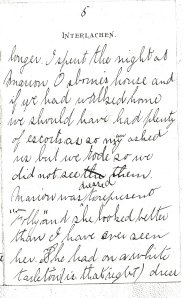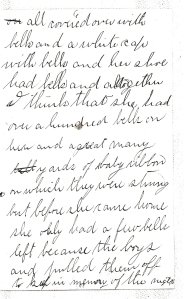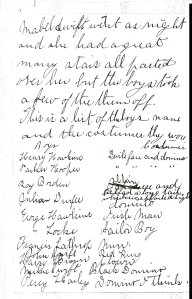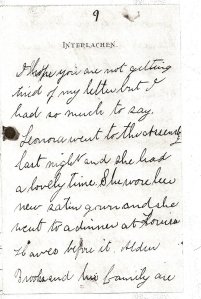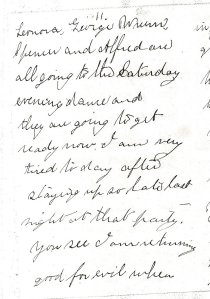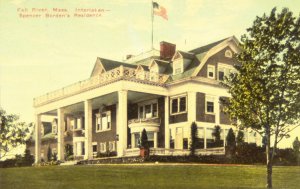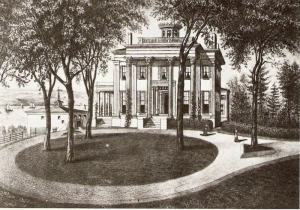(Recycled post – originally published in July, 2008)
Here’s a question I’ve pondered from time to time: Of those French Street and nearby neighbors, who might have visited Lizzie Borden that last year of her life? Weak and not recovered from her gall bladder operation, who went a-calling? No mystery in finding out who lived nearby; more difficult is assessing which neighbors would have visited her. One can only speculate. Here’s a scan from my 1926 and 1927 Fall River City Directories. Let’s take a peek at a sampling of those neighbors
.

Directly across the street from Lizzie at 309 French was Mrs. Emma Lake. Her son, Arthur Lake praised Lizzie in Joyce Williams’ Casebook, but there had been a property dispute between Lizzie and Mrs. Lake after Lizzie acquired half a lot adjacent and wanting it for an open park. It would seem Lizzie and Mrs. Lake ended their friendship on ugly terms. Perhaps Arthur was never made aware of that dispute.
 Lizzie’s nearest neighbor to the east would be at 328 French Street, shown above. The 1926 Directory shows this house as apartments with Edwin Belcher a tenant and school teacher Harriet E. Henry (listed in the Directory as “Hervey”). By the time of printing of the 1927 Directory, Edwin Belcher is no longer a tenant. This property was purchased in 1925 by Harriet and then sold to Charles C. Cook, Lizzie’s business manager, in trust for Lizzie about 7 months before Lizzie’s death. That particular transaction would end up being reviewed by the State Supreme Court, but we’ll skip the details for now. This property is alternately referred to as the Henry House or the Davenport House (a previous owner and relation to Harriet). Note: The rod iron spiked fencing separating the properties was installed by Lizzie.
Lizzie’s nearest neighbor to the east would be at 328 French Street, shown above. The 1926 Directory shows this house as apartments with Edwin Belcher a tenant and school teacher Harriet E. Henry (listed in the Directory as “Hervey”). By the time of printing of the 1927 Directory, Edwin Belcher is no longer a tenant. This property was purchased in 1925 by Harriet and then sold to Charles C. Cook, Lizzie’s business manager, in trust for Lizzie about 7 months before Lizzie’s death. That particular transaction would end up being reviewed by the State Supreme Court, but we’ll skip the details for now. This property is alternately referred to as the Henry House or the Davenport House (a previous owner and relation to Harriet). Note: The rod iron spiked fencing separating the properties was installed by Lizzie.
 Lizzie’s nearest neighbor to the west, 324 French, would be John T. Swift. Swift was the lawyer Alice Russell, her conscious weighing heavily, first told of the dress burning incident. Had Swift not advised Alice to tell it to District Attorney Hosea Knowlton, we would not even know who Lizzie Borden was 115 years later. Shown here left to right is the Swift house, Maplecroft, and the Henry/Davenport house. Photo taken in 1998.
Lizzie’s nearest neighbor to the west, 324 French, would be John T. Swift. Swift was the lawyer Alice Russell, her conscious weighing heavily, first told of the dress burning incident. Had Swift not advised Alice to tell it to District Attorney Hosea Knowlton, we would not even know who Lizzie Borden was 115 years later. Shown here left to right is the Swift house, Maplecroft, and the Henry/Davenport house. Photo taken in 1998.
 The next house east is 344 French where the widow Mrs. Isabella Hooper lived. Perhaps she and Lizzie visited? Exterior re-hab has been going on for years with this house and it looks much better in 2007. This photo was taken in 2005.
The next house east is 344 French where the widow Mrs. Isabella Hooper lived. Perhaps she and Lizzie visited? Exterior re-hab has been going on for years with this house and it looks much better in 2007. This photo was taken in 2005.  Across the street and slightly east from Maplecroft, this structure existed in 1926 but I’m unable to locate the number from the 1926 or 1927 Directory. It is now a commercial property and often referred to as the “Baker” lot. Lizzie bequeathed to Charles Cook “my so-called Baker lot on French Street across from where I live.” I took this photo in 1999.
Across the street and slightly east from Maplecroft, this structure existed in 1926 but I’m unable to locate the number from the 1926 or 1927 Directory. It is now a commercial property and often referred to as the “Baker” lot. Lizzie bequeathed to Charles Cook “my so-called Baker lot on French Street across from where I live.” I took this photo in 1999.
At the southeast corner of French and Belmont was John Summerfield Brayton, Jr., a BC&C (Big Cheese & Connected) whose crowing bird annoyed Lizzie and made her nervous over a quarter century before she died. Did John and Mary Brayton visit Lizzie? I don’t think so.
At 257 French was Everett M. Cook, Vice President of BMC Durfee Trust Company. Another BC&C, like so many on French Street. At 243 French was Elizabeth J. McWhirr, widow of Robert A. McWhirr, who may have been related to the great McWhirr department store. Did she go a-calling on Lizzie? I don’t think so.

At the southeast corner of French & June at 421 June was Marion Jennings – the daughter of attorney Andrew Jennings. It’s safe to say she did not call upon Lizzie. It’s further safe to say Marion had no knowledge of what lay inside an old hip bath covered with a tarp up in the attic of this house. Most likely, neither did Lizzie.
ON ROCK STREET:

Carrie L. Borden is listed in 1926 at 492 Rock Street, but in 1927, only her sister Anna H. Borden. These ladies went on the Grand Tour with Lizzie in 1890. It is my educated guess that they were the two sisters that spoke in confidence to author Edmund Pearson when he was writing his long, first essay on the Borden case in Studies in Murder. It’s highly doubtful these ladies went a-calling to Miss Lizbeth of Maplecroft.
At 618 Rock was Jerome C. Borden, son of Cook Borden and Grace Hartley Howe’s uncle, and strong supporter of Lizzie in 1892-93. Jerome succeeded Andrew as President of Union Bank, but it’s doubtful Jerome ever presented his calling card at Maplecroft during Lizzie’s last year. While most genetic threads were woven tightly, some weaves became irreparably tattered.
At 451 Rock Street was the formidable Elizabeth Hitchcock Brayton, whose nephew, having inherited this stately granite beauty, donated it to the Fall River Historical Society in 1935.
Actually, the 400 thru 700 blocks of Rock Street in 1927 reads like a Who’s Who of Fall River. However, after Lizzie died, Fall River had about one good year remaining before its economy and stratified society would fade and dissolve like so much smoke drift from the iconic mill chimineys that marked its once great prominence and vitality.
BACK TO FRENCH STREET
The interesting thing about French Street is that at #96 French Street, just west of Rock Street, we find Gertrude M. Baker,  long time English teacher at BMC Durfee High School. ( The 1927 Fall River High School Yearbook, “The Durfee Record”, is dedicated to Gertrude Baker). Gertrude owned a summer house on the beach in Linekin, East Boothbay, Maine. She was a friend of a later friend of Lizzie’s, Miss Helen Leighton (we’ll get to her in a moment) but the important thing is through this thread that bound, Miss Baker was a founder and Treasurer of the Fall River Animal Rescue League from 1914-1930. It seems more a gratuitous gesture for service rendered than one steeped in a personal friendship that Lizzie left Gertrude $1,000 in her Will. Miss Baker never married and when she died she left her money to her close friend, Helen Leighton, along with her beach house in Linekin. Lucky Helen.
long time English teacher at BMC Durfee High School. ( The 1927 Fall River High School Yearbook, “The Durfee Record”, is dedicated to Gertrude Baker). Gertrude owned a summer house on the beach in Linekin, East Boothbay, Maine. She was a friend of a later friend of Lizzie’s, Miss Helen Leighton (we’ll get to her in a moment) but the important thing is through this thread that bound, Miss Baker was a founder and Treasurer of the Fall River Animal Rescue League from 1914-1930. It seems more a gratuitous gesture for service rendered than one steeped in a personal friendship that Lizzie left Gertrude $1,000 in her Will. Miss Baker never married and when she died she left her money to her close friend, Helen Leighton, along with her beach house in Linekin. Lucky Helen.
Helen Leighton struck half of the mother lode upon Lizzie’s death being one of two primary legatees. Seven years younger than Lizzie, Miss Leighton graduated from nursing  school in Fall River a month before Lizzie went to Trial for the double hatchet homicide. Helen had been nurse and companion to Eudora Borden Dean, daughter of that very wealthy Captain of Fall River Industry, Jefferson Borden. Smart Helen. In 1913, she had successfully solicited money from Lizzie to start the Fall River Animal Rescue League of which she became its President. Clever Helen. She moved to Boston in 1919 and Lizzie visited her there, taking in galleries and the theatre. She moved to Brookline, MA. in 1924, and when she died in 1947, newspapers reporting on the Borden case were found stuffed inside the walls of the Linekin beach house.
school in Fall River a month before Lizzie went to Trial for the double hatchet homicide. Helen had been nurse and companion to Eudora Borden Dean, daughter of that very wealthy Captain of Fall River Industry, Jefferson Borden. Smart Helen. In 1913, she had successfully solicited money from Lizzie to start the Fall River Animal Rescue League of which she became its President. Clever Helen. She moved to Boston in 1919 and Lizzie visited her there, taking in galleries and the theatre. She moved to Brookline, MA. in 1924, and when she died in 1947, newspapers reporting on the Borden case were found stuffed inside the walls of the Linekin beach house.
So there they are: Gertrude, Helen, and Lizzie – they could have all three been sisters judging by how they looked in these photographs. It’s anyone’s guess as to who introduced who to whom in this three-some, a constellation in orbit around Lizzie’s moon. These dames were really out of the same mold. Same hair styles, same glasses, same kind of dresses. I can almost visualize them at the Animal Rescue League Board of Directors meeting or even taking their time walking through some museum in Boston or New York. Not exactly your party-hardy type broads. Uh uh. But oh so very proper, yes indeed. Decorum, decorum, decorum. All were proper spinsters who loved animals. None ever married or had children of their own to enrich their lives, to nurture, to enjoy, to love, and who would return that love.
Grace Hartley Howe hit the other half of the mother lode, inheriting half of Lizzie’s half of Maplecroft, furniture, jewelry, books, carpets, personal effects, etc. Grace’s grandfather was Cook Borden, a brother of Abraham, Andrew’s father.  In 1926, Grace and her husband Louis are in the 1926 Directory as having a residence at 636 Rock Street, but in 1927 Grace is living at 464 Locust. Louis McHenry Howe was chief advisor and political strategist to President Franklin Delano Roosevelt but lived in the White House, visiting his family at their Westport residence in Horseneck Beach. (Louis would die in 10 years and be buried at Oak Grove with FDR attending his funeral.) But here we see Grace was literally in walking distance to Lizzie in 1926 and 1927, and surely she must have visited her. I have long believed Grace was called by the Reverend Cleveland of the Church of Ascension and was at Maplecroft when Lizzie died. She would have been, after Emma, the next and, literally, nearest of kin. Ten years after Lizzie’s death, two years after the final probate of Lizzie’s Will, and one year after her husband died, Grace was appointed Postmistress of Fall River by President Roosevelt.
In 1926, Grace and her husband Louis are in the 1926 Directory as having a residence at 636 Rock Street, but in 1927 Grace is living at 464 Locust. Louis McHenry Howe was chief advisor and political strategist to President Franklin Delano Roosevelt but lived in the White House, visiting his family at their Westport residence in Horseneck Beach. (Louis would die in 10 years and be buried at Oak Grove with FDR attending his funeral.) But here we see Grace was literally in walking distance to Lizzie in 1926 and 1927, and surely she must have visited her. I have long believed Grace was called by the Reverend Cleveland of the Church of Ascension and was at Maplecroft when Lizzie died. She would have been, after Emma, the next and, literally, nearest of kin. Ten years after Lizzie’s death, two years after the final probate of Lizzie’s Will, and one year after her husband died, Grace was appointed Postmistress of Fall River by President Roosevelt.
Of these three women, Gertrude, Helen and Grace, two (Helen and Grace) gave newspaper interviews in the week after Lizzie died.  One other woman, definitely not neighbor nor friend of Lizzie’s when she died, also gave an interview – Nance O’Neil. Nance met Lizzie in 1904. By 1927, Nance had successfully transitioned from the stage to motion pictures. In the newspaper interview she remarked on Lizzie’s kindness, refinement, and intelligence, downplaying their relationship and characterizing it as “ships passing in the night.” She was not named in Lizzie’s Will. Nance lived long enough to have read several books on Lizzie published prior to 1965. Her ashes are entombed with her husband, Alfred Hickman at Forest Lawn cemetery in Glendale, California.
One other woman, definitely not neighbor nor friend of Lizzie’s when she died, also gave an interview – Nance O’Neil. Nance met Lizzie in 1904. By 1927, Nance had successfully transitioned from the stage to motion pictures. In the newspaper interview she remarked on Lizzie’s kindness, refinement, and intelligence, downplaying their relationship and characterizing it as “ships passing in the night.” She was not named in Lizzie’s Will. Nance lived long enough to have read several books on Lizzie published prior to 1965. Her ashes are entombed with her husband, Alfred Hickman at Forest Lawn cemetery in Glendale, California.
I think Lizzie was probably always ladylike and refined and masked her inner angst and depression when in public. We know she let that mask down with Miss Leighton, who, after Lizzie’s death, commented so definitively on Lizzie’s loneliness and depression in her later years. The Roaring Twenties, shorter skirts, bobbed hair, Lindberg racing across the Atlantic through the skies while she, Lizzie never did anything in a hurry. The “Flapper Age” must have come on like gangbusters and not suited her at all, much like the sexual liberation of the 1970’s to the Born Again Christians. No, I don’t think Lizzie liked the changing times. She was nervous and depressed enough and now all this fast living. (Mammy to Scarlett: “It ain’t fittin’, it just ain’t fittin’).
commented so definitively on Lizzie’s loneliness and depression in her later years. The Roaring Twenties, shorter skirts, bobbed hair, Lindberg racing across the Atlantic through the skies while she, Lizzie never did anything in a hurry. The “Flapper Age” must have come on like gangbusters and not suited her at all, much like the sexual liberation of the 1970’s to the Born Again Christians. No, I don’t think Lizzie liked the changing times. She was nervous and depressed enough and now all this fast living. (Mammy to Scarlett: “It ain’t fittin’, it just ain’t fittin’).
I can envision her, in her last year of life, sitting on her window box seat in her summer bedroom in Maplecroft. More alone and isolated than ever with only a tiny few who ever came a-calling. Dressed in a stylish lounging gown, too weak to go up and down the stairs every day, she would have spent much time wistfully looking at the houses below and at the young people coming and going. Perhaps a young man honking the horn of his tricked out Model T Ford for his girlfriend to come out. Twenty Three Skid-doo. I envision one of Lizzie’s dogs in her lap feeling the gentle strokes of her hand as she remembers a quieter time of proper deportment. The era of when ladies were ladies and conducted themselves accordingly was gone forever. Stroke…….Sigh……Stroke.
No wonder our “Lizbeth of Maplecroft” preferred Dickens and Trollup over F. Scott Fitzgerald.
Sources:
1926 & 1927 Fall River City Directory
Unveiled: Miss Helen Leighton by Leonard Rebello, Lizzie Borden Quarterly, October 2000, Vol VII, #4.
1927 BMC Durfee H.S. Yearbook.
Last Will and Testament of Lizzie Andrew Borden.
Knowlton-Pearson Correspondence, Fall River Historical Society.
Famous Actors and Actresses on the American Stage, vol. 2, by William C. Young, 1975.
Lizzie Borden- Past and Present, Leonard Rebello, Alzack Press, 1999.
Conversations with Robert Dube, owner, at 306 French Street, August 3 & 5, 2007.




 2016
2016





























 Lizzie’s nearest neighbor to the east would be at 328 French Street, shown above. The 1926 Directory shows this house as apartments with Edwin Belcher a tenant and school teacher Harriet E. Henry (listed in the Directory as “Hervey”). By the time of printing of the 1927 Directory, Edwin Belcher is no longer a tenant. This property was purchased in 1925 by Harriet and then sold to Charles C. Cook, Lizzie’s business manager, in trust for Lizzie about 7 months before Lizzie’s death. That particular transaction would end up being reviewed by the State Supreme Court, but we’ll skip the details for now. This property is alternately referred to as the Henry House or the Davenport House (a previous owner and relation to Harriet). Note: The rod iron spiked fencing separating the properties was installed by Lizzie.
Lizzie’s nearest neighbor to the east would be at 328 French Street, shown above. The 1926 Directory shows this house as apartments with Edwin Belcher a tenant and school teacher Harriet E. Henry (listed in the Directory as “Hervey”). By the time of printing of the 1927 Directory, Edwin Belcher is no longer a tenant. This property was purchased in 1925 by Harriet and then sold to Charles C. Cook, Lizzie’s business manager, in trust for Lizzie about 7 months before Lizzie’s death. That particular transaction would end up being reviewed by the State Supreme Court, but we’ll skip the details for now. This property is alternately referred to as the Henry House or the Davenport House (a previous owner and relation to Harriet). Note: The rod iron spiked fencing separating the properties was installed by Lizzie. Lizzie’s nearest neighbor to the west, 324 French, would be John T. Swift. Swift was the lawyer Alice Russell, her conscious weighing heavily, first told of the dress burning incident. Had Swift not advised Alice to tell it to District Attorney Hosea Knowlton, we would not even
Lizzie’s nearest neighbor to the west, 324 French, would be John T. Swift. Swift was the lawyer Alice Russell, her conscious weighing heavily, first told of the dress burning incident. Had Swift not advised Alice to tell it to District Attorney Hosea Knowlton, we would not even  The next house east is 344 French where the widow Mrs. Isabella Hooper lived. Perhaps she and Lizzie visited? Exterior re-hab has been going on for years with this house and it looks much better in 2007. This photo was taken in 2005.
The next house east is 344 French where the widow Mrs. Isabella Hooper lived. Perhaps she and Lizzie visited? Exterior re-hab has been going on for years with this house and it looks much better in 2007. This photo was taken in 2005.  Across the street and slightly east from Maplecroft, this structure existed in 1926 but I’m unable to locate the number from the 1926 or 1927 Directory. It is now a commercial property and often referred to as the “Baker” lot. Lizzie bequeathed to Charles Cook “my so-called Baker lot on French Street across from where I live.” I took this photo in 1999.
Across the street and slightly east from Maplecroft, this structure existed in 1926 but I’m unable to locate the number from the 1926 or 1927 Directory. It is now a commercial property and often referred to as the “Baker” lot. Lizzie bequeathed to Charles Cook “my so-called Baker lot on French Street across from where I live.” I took this photo in 1999.

 long time English teacher at BMC Durfee High School. (
long time English teacher at BMC Durfee High School. (  school in Fall River a month before Lizzie went to Trial for the double hatchet homicide. Helen had been nurse and companion to Eudora Borden Dean, daughter of that very wealthy Captain of Fall River Industry, Jefferson Borden. Smart Helen. In 1913, she had successfully solicited money from Lizzie to start the Fall River Animal Rescue League of which she became its President. Clever Helen. She moved to Boston in 1919 and Lizzie visited her there, taking in galleries and the theatre. She moved to Brookline, MA. in 1924, and when she died in 1947, newspapers reporting on the Borden case were found stuffed inside the walls of the Linekin beach house.
school in Fall River a month before Lizzie went to Trial for the double hatchet homicide. Helen had been nurse and companion to Eudora Borden Dean, daughter of that very wealthy Captain of Fall River Industry, Jefferson Borden. Smart Helen. In 1913, she had successfully solicited money from Lizzie to start the Fall River Animal Rescue League of which she became its President. Clever Helen. She moved to Boston in 1919 and Lizzie visited her there, taking in galleries and the theatre. She moved to Brookline, MA. in 1924, and when she died in 1947, newspapers reporting on the Borden case were found stuffed inside the walls of the Linekin beach house. In 1926, Grace and her husband Louis are in the 1926 Directory as having a residence at 636 Rock Street, but in 1927 Grace is living at 464 Locust.
In 1926, Grace and her husband Louis are in the 1926 Directory as having a residence at 636 Rock Street, but in 1927 Grace is living at 464 Locust.  One other woman, definitely not neighbor nor friend of Lizzie’s when she died, also gave an interview – Nance O’Neil. Nance met Lizzie in 1904. By 1927, Nance had successfully
One other woman, definitely not neighbor nor friend of Lizzie’s when she died, also gave an interview – Nance O’Neil. Nance met Lizzie in 1904. By 1927, Nance had successfully  commented so definitively on Lizzie’s loneliness and depression in her later years. The Roaring Twenties, shorter skirts, bobbed hair, Lindberg racing across the Atlantic through the skies while she, Lizzie never did anything in a hurry. The
commented so definitively on Lizzie’s loneliness and depression in her later years. The Roaring Twenties, shorter skirts, bobbed hair, Lindberg racing across the Atlantic through the skies while she, Lizzie never did anything in a hurry. The 




 Working girls in the mill.
Working girls in the mill. A family takes time out for some fun in their store.
A family takes time out for some fun in their store. A fancy hearse.
A fancy hearse.












 were carved out by the same glacial activity that forged a chain of long, narrow lakes east of the hill, which funnel into the Quequechan River. With the force of the lakes behind it, the river descends rapidly with a fall of 130 feet in one half mile before it joins the waters of the bay.
were carved out by the same glacial activity that forged a chain of long, narrow lakes east of the hill, which funnel into the Quequechan River. With the force of the lakes behind it, the river descends rapidly with a fall of 130 feet in one half mile before it joins the waters of the bay. job at seven o’clock and, except for a toot at noon, didn’t blow again until five-thirty, with no coffee breaks and only a half-hour for lunch. The short lunch break posed a problem in getting these hardworking people fed. It was before the days of company cafeterias, and there wasn’t time enough to go home. This is how my friends and I earned our spending money. We carried dinners to the mills, either for our parents and relatives or for families whose children were grown.
job at seven o’clock and, except for a toot at noon, didn’t blow again until five-thirty, with no coffee breaks and only a half-hour for lunch. The short lunch break posed a problem in getting these hardworking people fed. It was before the days of company cafeterias, and there wasn’t time enough to go home. This is how my friends and I earned our spending money. We carried dinners to the mills, either for our parents and relatives or for families whose children were grown. Thus this ingenious pail carried a whole dinner. The meals were prepared at home and carried by us children to the mills. The school day was broken up into two sessions, with a two-hour break in between, so at eleven-thirty hundreds of school children poured out of my school, rushed home to pick up the dinners, then set off for the mills, hurrying to get there before the noon whistle blew. There was no lingering to talk with friends on the way, but coming back I could saunter along if it was warm. If it was cold, I wasted no time getting back to my own warm dinner. I remember walking through snow up to my hips and through drenching rainstorms that made it feel as though my journey was a long one. But it couldn’t have been very far if I walked to the mill and back, ate my own dinner, and got back to school by one-thirty.
Thus this ingenious pail carried a whole dinner. The meals were prepared at home and carried by us children to the mills. The school day was broken up into two sessions, with a two-hour break in between, so at eleven-thirty hundreds of school children poured out of my school, rushed home to pick up the dinners, then set off for the mills, hurrying to get there before the noon whistle blew. There was no lingering to talk with friends on the way, but coming back I could saunter along if it was warm. If it was cold, I wasted no time getting back to my own warm dinner. I remember walking through snow up to my hips and through drenching rainstorms that made it feel as though my journey was a long one. But it couldn’t have been very far if I walked to the mill and back, ate my own dinner, and got back to school by one-thirty. as the youngest child was in school. So when my younger sister started school, my mother went back to her old job as a weaver, and I was considered old enough to bring her lunch. After all, my grandmother, who had been born during the Industrial Revolution in England, had actually worked in a mill from dawn to dusk when she was just a year older than I. All I was asked to do was carry a pail. I felt capable of it and proud to be “carrying dinners” along with my friends.
as the youngest child was in school. So when my younger sister started school, my mother went back to her old job as a weaver, and I was considered old enough to bring her lunch. After all, my grandmother, who had been born during the Industrial Revolution in England, had actually worked in a mill from dawn to dusk when she was just a year older than I. All I was asked to do was carry a pail. I felt capable of it and proud to be “carrying dinners” along with my friends.
 tipped perilously at each bump. The brass bindings were loose, and I was terrified that I would trip on the step and spill the dinner pail’s contents. Each trip down was a nightmare as I made my way, step by step, until I reached the bottom and struggled to open the other heavy door. Only then could I relax my viselike grip on the pail and breathe a little more easily as I crossed the spinning room: rows and rows of spindles where that marvelous spinning jenny quietly twisted the yarn into thread.
tipped perilously at each bump. The brass bindings were loose, and I was terrified that I would trip on the step and spill the dinner pail’s contents. Each trip down was a nightmare as I made my way, step by step, until I reached the bottom and struggled to open the other heavy door. Only then could I relax my viselike grip on the pail and breathe a little more easily as I crossed the spinning room: rows and rows of spindles where that marvelous spinning jenny quietly twisted the yarn into thread. with a life of its own. I would watch fascinated as the shuttle carrying the warp flew back and forth between the two rows of thread, while the heavy harness banged each row taut. It always looked as though the harness was trying to catch the shuttle in mid-flight, and I would wait nervously for the disaster to happen. But in spite of appearances, the looms were well under the control of the workers, who paced back and forth between the rows, changing bobbins and watching for imperfections in the woven cloth, each one tending from two to six looms. Spoken communication was impossible, but the workers became adept at carrying on long conversations in sign language. I couldn’t understand all of it, but I watched with admiration as they talked. A woman told my mother of a telephone call she had had, and the motions of her hands described the conversation perfectly.
with a life of its own. I would watch fascinated as the shuttle carrying the warp flew back and forth between the two rows of thread, while the heavy harness banged each row taut. It always looked as though the harness was trying to catch the shuttle in mid-flight, and I would wait nervously for the disaster to happen. But in spite of appearances, the looms were well under the control of the workers, who paced back and forth between the rows, changing bobbins and watching for imperfections in the woven cloth, each one tending from two to six looms. Spoken communication was impossible, but the workers became adept at carrying on long conversations in sign language. I couldn’t understand all of it, but I watched with admiration as they talked. A woman told my mother of a telephone call she had had, and the motions of her hands described the conversation perfectly. my mother, its contents intact. At twelve o’clock the looms stopped, and the weavers were free to enjoy their lunches in the deafening silence.
my mother, its contents intact. At twelve o’clock the looms stopped, and the weavers were free to enjoy their lunches in the deafening silence.






